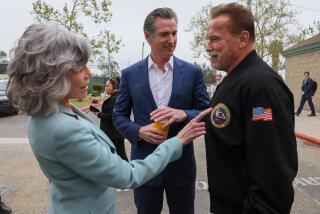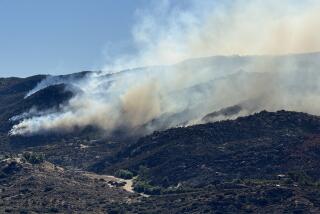Analysis: Latest oil spill echoes 1969, but with less of the political fallout
Along the coastline west of Santa Barbara last week rose an apparition from 1969, as oil defiled the surface of the Pacific, the beachside rocks, wildlife.
The catastrophe offshore from Santa Barbara 46 years ago was massive — 3 million gallons of oil, its release unstoppable for weeks. The political impact was massive as well, as it essentially created one of California’s premier movements, environmental protection.
Tuesday’s spill is likely to leave a less-lasting footprint, for myriad reasons.
It was smaller, at 21,000 gallons in the water and perhaps five times that much on land. And although the big one was a shocker, this one really isn’t, not after the Exxon Valdez spill and the more recent Gulf of Mexico blowout.
But there is another, more positive reason why this disaster may prove less politically meaningful: So much of the organizational hard work was accomplished back then that there are fewer fixes to make.
In the wake of the 1969 spill, governmental agencies were created to protect the environment; their workers stalked the beach in white suits last week, replacing the volunteers who in 1969 tossed hay at the sea to soak up oil. Environmental groups sprang to life and have stayed potent.
And though there was dissent among California politicians about offshore drilling back then, there is almost none now. Climate change and fracking have filled the vacuum.
“It’s bad politics to support offshore oil drilling, for anyone in either political party in California,” said Eric R.A.N. Smith, a UC Santa Barbara professor who specializes in environmental politics.
Indeed, Field Poll surveys show Californians have consistently objected to more offshore drilling since 1984, lessening their disapproval only slightly in periods of high gas prices.
Since then, the oil drilling issue has mostly been used to signal moderation on the part of some Republican politicians. Pete Wilson opposed offshore drilling en route to two elections as U.S. senator in the 1980s and two terms as governor in the 1990s. Arnold Schwarzenegger spent substantial political heft on the environment when he was governor, signing the climate change bill AB 32 during his 2006 reelection campaign.
(The reverse hasn’t fared well. The 2008 Republican presidential nominee, John McCain, 2010 Senate candidate Carly Fiorina and that year’s gubernatorial nominee, Meg Whitman, tried to reverse Schwarzenegger’s stances. All three lost.)
So drilling has mostly vanished from the political conversation, much as capital punishment ceased to be a demarcation when the state’s politicians began backing it. Thus, Gov. Jerry Brown has begun to focus on climate change as one of his career-topping issues.
Last week, he brought national and world leaders to Sacramento to forge an agreement aimed at reducing greenhouse emission levels. Last month, he issued a surprise order to hasten the state’s emission levels to 40% below the 1990 figure by 2030, on the way to even lower levels set by Schwarzenegger.
In a speech the day of his order, Brown criticized the Republican-led Congress for “magical thinking” in denying climate change. “If the federal government, in the legislative branch, can’t get it right, then we in California are going to do our part to take care of business here.”
But Brown’s efforts — like Schwarzenegger’s before — rest on the notion that Californians are all in on the entire environmental front. The reality seems slightly different.
To judge by polls taken the last several years, Californians appear to be something of a mixed up lot; wanting to cut water use and also have gloriously green lawns, to drive gas guzzlers but object to drilling and fracking, the practice of injecting chemicals into deep rock to loosen oil and gas deposits; to favor environmental protections and yet demand the economic development that those protections can complicate; to want cheap electricity but to not want nuclear power plants and wind farms nearby.
To have to be led, occasionally reluctantly, into a new energy future is not necessarily surprising, Smith said.
“We are like that,” he said. “In all the California polls asking about offshore oil, we see a persistent pattern of people wanting to do good things for the environment and not wanting to sacrifice.”
A fierce driver of demand for environmental protection is the state’s demographic shift, which has done so much to turn California from Republican-dominated to a Democratic fiefdom, and changed its views on issues like immigration, same-sex marriage and abortion rights.
Latinos have long been more supportive of environmental protections than white voters; a 2013 USC/Times poll found that 55% of Latinos wanted an immediate ban on fracking, whereas 42% of whites shared that view. Their skepticism of oil companies is driven by experience: Many immigrant-heavy neighborhoods are industrial and their residents suffer from air and toxic pollution.
“Not just the oil industry, but heavy industry in general, made an assumption that if people were low income they could treat them badly,” said Carl Pope, who was chairman of the Sierra Club for 11 years until 2011. “Basically we had an intense laboratory in which the future majority in California was taught not to trust the oil industry.”
That notion was reinforced west of Santa Barbara last week. If 1969’s spill was an eye-opener for many Californians, this one was at least a miserable reminder.
Twitter: @cathleendecker. For more on California politics, go to https://www.latimes.com/decker.
More to Read
Start your day right
Sign up for Essential California for news, features and recommendations from the L.A. Times and beyond in your inbox six days a week.
You may occasionally receive promotional content from the Los Angeles Times.







